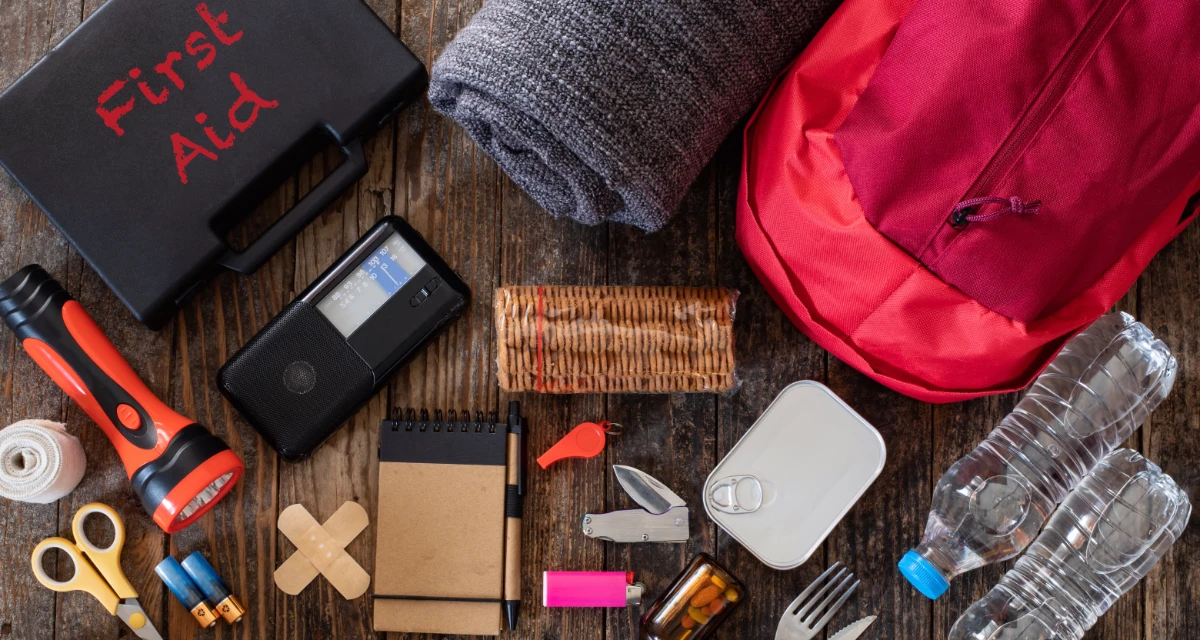When disaster strikes, the difference between safety and chaos often comes down to how well we’ve prepared. While we can’t control the forces of nature, we can certainly arm ourselves with the right supplies to face them head-on. Let’s dive into what you should have on hand to ensure you’re ready when the unexpected happens.

Stock Up on Food and Water
In the face of a natural disaster, your regular food and water supply might not be reliable. Start with storing non-perishable food items that can sustain you and your loved ones for at least three days. Think canned vegetables, dry grains, and energy bars – foods that don’t require refrigeration or cooking. Water is even more critical. Aim to store at least one gallon per person per day. This will cover drinking and sanitation needs, keeping you hydrated and clean.
Health is Your Wealth
Your well-being is paramount during a crisis. A well-stocked first aid kit is your first line of defense. Include basic medical supplies alongside any prescription medications you or your family members might need. Don’t forget hygiene products. Items like soap, toothpaste, and sanitizers will keep germs at bay when regular facilities may not be available.
Communication and Power Essentials
When the power goes out, staying informed becomes a challenge. A battery-powered or hand-crank radio can be a lifeline, providing you with crucial updates. Flashlights and extra batteries are non-negotiables, ensuring you’re never left in the dark. And in today’s connected world, having a way to charge your mobile device can keep you in touch with loved ones and emergency services.
Safety and Comfort Matter
In the aftermath of a disaster, you might need to fend for yourself for a while. Extra clothing and bedding can provide comfort and warmth in tough times. If you’re forced to evacuate, having a portable shelter like a tent or space blanket can offer temporary refuge. Keep personal documents in a waterproof container; they’ll be invaluable for identification and accessing services post-disaster.
Tools for Survival and Recovery
When infrastructure is compromised, a set of basic tools can be incredibly handy. Whether it’s for making quick repairs or turning off utilities, a multi-tool or basic toolkit can go a long way. Sanitation supplies like trash bags and disinfectants will help maintain a clean environment, reducing the risk of illness.
Preparing Your Home and Family
Ensuring your home is ready to withstand a disaster is just as crucial as your personal preparedness. Secure heavy furniture and items that could become hazards. Identify safe zones where family members can seek refuge during events like earthquakes or tornadoes. And most importantly, establish a clear and practiced emergency plan with your family. Knowing what to do and where to go can save precious time and lives.
Before wrapping up, remember that your disaster preparedness kit should be tailored to your specific needs and the types of natural disasters common in your area. And while having the right supplies is vital, knowledge and planning are equally crucial. Stay informed about the potential risks in your region and update your plans and supplies regularly.
For further guidance and a comprehensive list of suggested supplies, visiting Ready.gov is an excellent next step. They offer detailed checklists and tips to help you prepare for any emergency situation.
In the end, the goal is not just to survive but to do so with dignity and resilience. By taking the time to prepare now, you can face the future with confidence, knowing you’re ready to handle whatever comes your way.